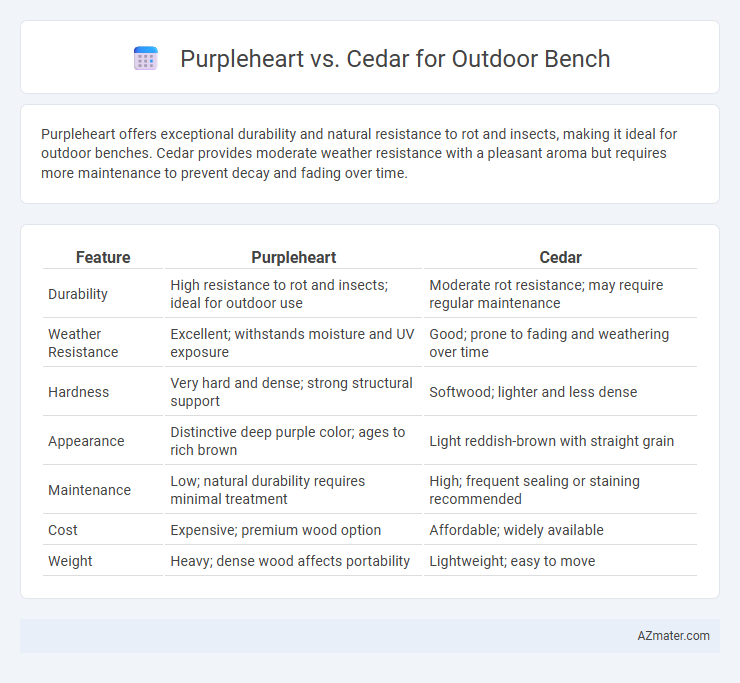Purpleheart offers exceptional durability and natural resistance to rot and insects, making it ideal for outdoor benches. Cedar provides moderate weather resistance with a pleasant aroma but requires more maintenance to prevent decay and fading over time.
Table of Comparison
| Feature | Purpleheart | Cedar |
|---|---|---|
| Durability | High resistance to rot and insects; ideal for outdoor use | Moderate rot resistance; may require regular maintenance |
| Weather Resistance | Excellent; withstands moisture and UV exposure | Good; prone to fading and weathering over time |
| Hardness | Very hard and dense; strong structural support | Softwood; lighter and less dense |
| Appearance | Distinctive deep purple color; ages to rich brown | Light reddish-brown with straight grain |
| Maintenance | Low; natural durability requires minimal treatment | High; frequent sealing or staining recommended |
| Cost | Expensive; premium wood option | Affordable; widely available |
| Weight | Heavy; dense wood affects portability | Lightweight; easy to move |
Introduction: Comparing Purpleheart and Cedar for Outdoor Benches
Purpleheart offers exceptional durability and vibrant purple hues that deepen with age, making it a striking choice for outdoor benches exposed to the elements. Cedar is naturally resistant to decay and insects, with a lighter, warm tone that blends seamlessly into garden settings. Both woods provide excellent weather resistance, but Purpleheart's density ensures longer lifespan while Cedar offers easier workability and a classic outdoor appearance.
Wood Durability: Purpleheart vs Cedar
Purpleheart wood exhibits exceptional durability for outdoor benches due to its high density and natural resistance to rot, insects, and decay, making it suitable for long-term exposure to harsh weather conditions. In contrast, cedar is moderately durable, offering good resistance to moisture and insect damage but requiring regular maintenance like sealing or staining to prolong its lifespan. While purpleheart often outperforms cedar in toughness and longevity, cedar's natural oils and aroma provide added protection and aesthetic value in outdoor settings.
Weather Resistance and Outdoor Performance
Purpleheart wood exhibits exceptional weather resistance due to its natural oils and dense grain, making it highly resilient against moisture, decay, and insect damage in outdoor settings. Cedar offers moderate weather resistance with natural rot-resistant compounds, but it is softer and more prone to dents and scratches, requiring regular maintenance to preserve its durability. For long-lasting outdoor bench performance, Purpleheart's superior hardness and stability ensure better long-term resistance to harsh environmental conditions compared to cedar.
Appearance and Color: Aesthetic Differences
Purpleheart showcases a rich, deep purple hue that darkens to a reddish-brown over time, offering a unique and striking appearance for outdoor benches. Cedar features a warm, reddish-orange tone with natural variations and pale streaks, creating a classic and rustic aesthetic. The vibrant, jewel-toned color of Purpleheart contrasts sharply with Cedar's softer, earthy shades, making color choice a defining factor in outdoor bench design.
Maintenance Requirements for Each Wood
Purpleheart wood requires occasional sealing with a high-quality exterior finish to maintain its vibrant purple hue and prevent weather-related damage such as fading or cracking. Cedar naturally resists rot, decay, and insect infestations, reducing the need for frequent treatments, but benefits from annual applications of a protective oil or water-repellent preservative to prolong its life and maintain appearance. Both woods demand periodic inspections for signs of wear, with Purpleheart needing more attentive care to preserve its intense color in outdoor bench applications.
Cost Comparison: Purpleheart vs Cedar
Purpleheart wood is generally more expensive than cedar due to its density, durability, and vibrant color, making it a premium choice for outdoor benches. Cedar is more affordable, widely available, and naturally resistant to decay and insects, providing a cost-effective option for long-lasting outdoor furniture. When comparing cost, cedar offers better value for budget-conscious projects, while purpleheart commands a higher price reflecting its unique aesthetic and superior hardness.
Workability and Ease of Construction
Purpleheart offers excellent workability with a uniform grain that sands smoothly and holds nails and screws securely, ideal for intricate outdoor bench designs. Cedar, known for its lightweight and soft texture, is easier to cut and shape but may require more care to avoid splitting during assembly. Both woods provide good stability outdoors, but Purpleheart's higher density demands sharper tools, whereas Cedar allows quicker construction with less effort.
Environmental Sustainability Considerations
Purpleheart wood offers exceptional durability and resistance to decay, making it a sustainable choice for outdoor benches as it reduces the need for frequent replacements. Cedar wood is naturally resistant to insects and rot, and it is often sourced from well-managed forests with sustainable harvesting practices. Both woods contribute to environmental sustainability by providing long-lasting, low-maintenance options that minimize resource consumption and environmental impact.
Longevity and Lifespan of Outdoor Benches
Purpleheart wood offers exceptional durability and resistance to decay, making it ideal for outdoor benches that require long-lasting performance in harsh weather conditions. Cedar, while naturally resistant to rot and insects, typically has a shorter lifespan compared to Purpleheart, especially in environments with high moisture or direct sun exposure. The dense grain of Purpleheart enhances its resilience against warping and cracking, extending the bench's longevity significantly beyond that of cedar.
Conclusion: Which Wood Is Best for Your Outdoor Bench?
Purpleheart offers exceptional durability and vibrant color retention, making it ideal for outdoor benches exposed to harsh weather conditions. Cedar provides natural resistance to decay and insects with a lighter, more traditional aesthetic that weathers to a charming silver-gray patina. Choosing between Purpleheart and Cedar depends on whether you prioritize long-lasting strength and rich color or a classic, aromatic wood that ages gracefully outdoors.

Infographic: Purpleheart vs Cedar for Outdoor Bench
 azmater.com
azmater.com